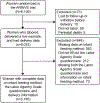Maternal Sense of Control During Childbirth and Infant Feeding Method
- PMID: 32028504
- PMCID: PMC7036026
- DOI: 10.1097/AOG.0000000000003697
Maternal Sense of Control During Childbirth and Infant Feeding Method
Abstract
Objective: To estimate whether maternal sense of control in labor is associated with breastfeeding at 4-8 weeks postpartum.
Methods: This is a secondary analysis of data from a multicenter randomized controlled trial of elective induction of labor at 39 weeks of gestation in low-risk nulliparous women. In this trial, women completed the Labor Agentry Scale, a validated measure of women's feelings of control over the childbirth process, 6-96 hours after delivery. The Labor Agentry Scale score, which is higher with more perceived control during childbirth, was analyzed both as a continuous and a categorical variable (quintiles). Self-reported breastfeeding at 4-8 weeks postpartum was categorized as exclusive breastfeeding, breastfeeding and formula feeding, or exclusive formula feeding. Women were included in this analysis if they labored, filled out a Labor Agentry Scale questionnaire, had a neonate who survived until the postpartum visit, and provided information on infant feeding. Multinomial logistic regression was used to adjust for confounders.
Results: Of 5,185 women, 32.9% (n=1,705) were exclusively breastfeeding, 31.2% (n=1,620) were breastfeeding and formula feeding, and 35.9% (n=1,860) were exclusively formula feeding 4-8 weeks after delivery. Overall Labor Agentry Scale score ranged from 34 to 203 (median 167, interquartile range 145-182). The median Labor Agentry Scale score was 169 (interquartile range 151-183) for women exclusively breastfeeding, 166 (interquartile range 142-182) for women who were breastfeeding and formula feeding, and 164 (interquartile range 142-181) for women who were only formula feeding (P<.001). In the unadjusted multinomial model, women with Labor Agentry Scale scores in the lowest two quintiles (ie, those with lower perceived control during childbirth) were less likely to be exclusively breastfeeding (as compared with those exclusively formula feeding) than women in the highest Labor Agentry Scale quintile. When controlling for confounders, however, this association was no longer significant.
Conclusion: After adjustment for confounders, perceived control during childbirth was not associated with breastfeeding at 4-8 weeks postpartum among nulliparous women.
Clinical trial registration: ClinicalTrials.gov, NCT01990612.
Conflict of interest statement
Financial Disclosure
Sindhu K. Srinivas disclosed receiving funding from law firms for expert witness work. The other authors did not report any potential conflicts of interest.
Figures
Similar articles
-
Maternal and Delivery Characteristics and Self-Reported Perceived Control During Labor.Obstet Gynecol. 2023 Jul 1;142(1):117-124. doi: 10.1097/AOG.0000000000005230. Obstet Gynecol. 2023. PMID: 37290106 Free PMC article. Clinical Trial.
-
Effects of psychosocial support during labour and childbirth on breastfeeding, medical interventions, and mothers' wellbeing in a Mexican public hospital: a randomised clinical trial.Br J Obstet Gynaecol. 1998 Oct;105(10):1056-63. doi: 10.1111/j.1471-0528.1998.tb09936.x. Br J Obstet Gynaecol. 1998. PMID: 9800927 Clinical Trial.
-
The relationship between birthing related factors and maternal breastfeeding confidence in China.Women Birth. 2021 Mar;34(2):196-202. doi: 10.1016/j.wombi.2020.02.014. Epub 2020 Feb 26. Women Birth. 2021. PMID: 32113872
-
The Effect of Labor Comfort on Traumatic Childbirth Perception, Post-Traumatic Stress Disorder, and Breastfeeding.Breastfeed Med. 2020 Dec;15(12):779-788. doi: 10.1089/bfm.2020.0138. Epub 2020 Sep 3. Breastfeed Med. 2020. PMID: 32896164
-
Interventions for supporting the initiation and continuation of breastfeeding among women who are overweight or obese.Cochrane Database Syst Rev. 2019 Sep 17;9(9):CD012099. doi: 10.1002/14651858.CD012099.pub2. Cochrane Database Syst Rev. 2019. PMID: 31529625 Free PMC article.
Cited by
-
Birth experience during COVID-19 confinement (CONFINE): protocol for a multicentre prospective study.BMJ Open. 2020 Dec 10;10(12):e043057. doi: 10.1136/bmjopen-2020-043057. BMJ Open. 2020. PMID: 33303470 Free PMC article.
References
-
- Hansstein FV. The Impact of Breastfeeding on Early Childhood Obesity: Evidence From the National Survey of Children’s Health. Am J Health Promot. 2016;30(4):250–258. - PubMed
-
- Thompson JMD, Tanabe K, Moon RY, et al. Duration of Breastfeeding and Risk of SIDS: An Individual Participant Data Meta-analysis. Pediatrics. 2017;140(5). - PubMed
-
- Bartick MC, Jegier BJ, Green BD, Schwarz EB, Reinhold AG, Stuebe AM. Disparities in Breastfeeding: Impact on Maternal and Child Health Outcomes and Costs. J Pediatr. 2017;181:49–55 e46. - PubMed
Publication types
MeSH terms
Associated data
Grants and funding
- U10 HD040500/HD/NICHD NIH HHS/United States
- U10 HD040544/HD/NICHD NIH HHS/United States
- UG1 HD034116/HD/NICHD NIH HHS/United States
- UG1 HD040560/HD/NICHD NIH HHS/United States
- UG1 HD053097/HD/NICHD NIH HHS/United States
- U10 HD040485/HD/NICHD NIH HHS/United States
- U10 HD034116/HD/NICHD NIH HHS/United States
- UG1 HD068258/HD/NICHD NIH HHS/United States
- U10 HD027869/HD/NICHD NIH HHS/United States
- U10 HD040560/HD/NICHD NIH HHS/United States
- U10 HD040545/HD/NICHD NIH HHS/United States
- U01 HD036801/HD/NICHD NIH HHS/United States
- UG1 HD027869/HD/NICHD NIH HHS/United States
- U10 HD068268/HD/NICHD NIH HHS/United States
- UL1 TR001863/TR/NCATS NIH HHS/United States
- UG1 HD087230/HD/NICHD NIH HHS/United States
- UG1 HD027915/HD/NICHD NIH HHS/United States
- UG1 HD087192/HD/NICHD NIH HHS/United States
- UG1 HD040544/HD/NICHD NIH HHS/United States
- UG1 HD034208/HD/NICHD NIH HHS/United States
- UG1 HD040512/HD/NICHD NIH HHS/United States
- U10 HD027915/HD/NICHD NIH HHS/United States
- U10 HD068282/HD/NICHD NIH HHS/United States
- UG1 HD040545/HD/NICHD NIH HHS/United States
- UG1 HD040485/HD/NICHD NIH HHS/United States
- UG1 HD068268/HD/NICHD NIH HHS/United States
- U10 HD034208/HD/NICHD NIH HHS/United States
- U10 HD053097/HD/NICHD NIH HHS/United States
- U10 HD068258/HD/NICHD NIH HHS/United States
- UG1 HD040500/HD/NICHD NIH HHS/United States
- UG1 HD068282/HD/NICHD NIH HHS/United States
- U10 HD040512/HD/NICHD NIH HHS/United States
- UL1 TR001873/TR/NCATS NIH HHS/United States
- P2C HD050924/HD/NICHD NIH HHS/United States
- U10 HD036801/HD/NICHD NIH HHS/United States
- U24 HD036801/HD/NICHD NIH HHS/United States



